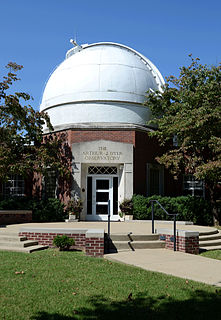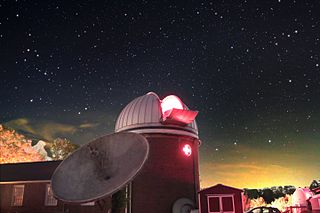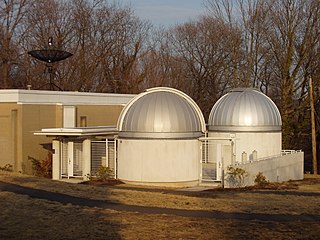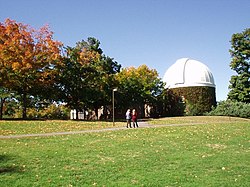Timeline of telescopes, observatories, and observing technology.

Yerkes Observatory is an astronomical observatory located in Williams Bay, Wisconsin, U.S.A. It was operated by the University of Chicago Department of Astronomy and Astrophysics from its founding in 1897 to 2020. Ownership was transferred to the non-profit Yerkes Future Foundation (YFF) in May 2020.

The Pulkovo Astronomical Observatory, the principal astronomical observatory of the Russian Academy of Sciences, located 19 km south of Saint Petersburg on Pulkovo Heights 75 metres (246 ft) above sea level. It is part of the UNESCO World Heritage Site Historic Centre of Saint Petersburg and Related Groups of Monuments.

Perkins Observatory is an astronomical observatory in Delaware, Ohio. It is owned and operated by Ohio Wesleyan University.

The Institute of Astronomy (IoA) is the largest of the three astronomy departments in the University of Cambridge, and one of the largest astronomy sites in the UK. Around 180 academics, postdocs, visitors and assistant staff work at the department.

The Dyer Observatory, also known as the Arthur J. Dyer Observatory, is an astronomical observatory owned and operated by Vanderbilt University. Built in 1953, it is located in Brentwood, Tennessee, and is the only university facility not located on the main campus in Nashville. The observatory is named after Arthur J. Dyer, who paid for the observatory's 24-foot (7.3 m)-wide dome, and houses a 24-inch (610 mm) reflecting telescope named for astronomer Carl Seyfert. Today, the observatory primarily serves as a teaching tool; its mission is to interest the public in the fields of astronomy, science and engineering. The observatory was listed on the National Register of Historic Places on March 6, 2009.

Chamberlin Observatory is an astronomical observatory owned and operated by the University of Denver. It is located in Denver, Colorado (US) in Observatory Park. It is named for Humphrey B. Chamberlin, a Denver real estate magnate who pledged $50,000 in 1888 to build and equip the facility.

Custer Observatory is an astronomical observatory owned and operated by Custer Institute. Located in Southold, New York (US), facing Peconic Bay and Shelter Island, Custer's location boasts some of the darkest skies on Long Island.

The Yale University Observatory, also known as the Leitner Family Observatory and Planetarium, is an astronomical observatory owned and operated by Yale University, and maintained for student use. It is located in Farnham Memorial Gardens near the corner of Edwards and Prospect Streets, New Haven, Connecticut.

Anderson Mesa Station is an astronomical observatory established in 1959 as a dark-sky observing site for Lowell Observatory. It is located at Anderson Mesa in Coconino County, Arizona (USA), about 12 miles southeast of Lowell's main campus on Mars Hill in Flagstaff, Arizona.

For the mountains in Tajikistan, see the Fann Mountains.

Shattuck Observatory is an astronomical observatory owned and operated by Dartmouth College in Hanover, New Hampshire, United States.

The University of Illinois Astronomical Observatory, located at 901 S. Mathews Avenue in Urbana, Illinois, on the campus of the University of Illinois Urbana-Champaign, was built in 1896, and was designed by Charles A. Gunn. It has been listed on the National Register of Historic Places since November 6, 1986, and on December 20, 1989, was designated a National Historic Landmark.

The Mills Observatory in Dundee, Scotland, is the first purpose-built public astronomical observatory in the UK. Built in 1935, the observatory is classically styled in sandstone and has a distinctive 7 m dome, which houses a Victorian refracting telescope, a small planetarium, and display areas. The dome is one of two made from papier-mâché to survive in the UK, the other being at the Godlee Observatory.

Fuertes Observatory is an astronomical observatory located on the North Campus of Cornell University in Ithaca, New York. The observatory was designed by L.P. Burnham, Cornell Professor of Architecture and completed in fall of 1917. It was originally used by the Civil Engineering Department as an instructional field office for navigation and surveying. Today, the observatory is primarily used for public outreach, welcoming over two thousand visitors per year with open houses on clear Friday nights.

The Dearborn Observatory is an astronomical observatory located on the Evanston campus of Northwestern University. The observatory was originally constructed in 1888, through an agreement between the university and the Chicago Astronomical Society. In the summer of 1939, Dearborn Observatory had to be moved to make way for the construction of the Technological Institute.

John Monroe Van Vleck was an American mathematician and astronomer. He taught astronomy and mathematics at Wesleyan University in Middletown, Connecticut for more than 50 years (1853-1912), and served as acting university president twice. The Van Vleck Observatory and the crater Van Vleck on the Moon are named after him.

J A Jones Hoober Observatory is a privately owned observatory located in South Yorkshire, England near to the villages of Hoober and Wentworth, 4 miles (6.4 km) North-northwest of Rotherham. It can be found about 300 metres (0.19 mi) east of Hoober Stand. The observatory is owned and operated by Mexborough & Swinton Astronomical Society (NPO).

McMillin Observatory was an astronomical observatory built around 1895 on the campus of Ohio State University. Named after Emerson McMillin and operated by the university, the observatory closed in 1968 and its telescope later moved to Ballreich Observatory. The observatory was equipped with photographic cameras, a filar micrometer, and a custom Brashear spectroscope. The observatory had two main focuses, education and at least one astronomic scientific research study focus.

Olin Observatory is an astronomical observatory in New London, Connecticut (USA), owned and operated by Connecticut College. It is part of the F.W. Olin Science Center. The observatory hosts public stargazing events, and is also used for undergraduate instruction.


















